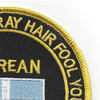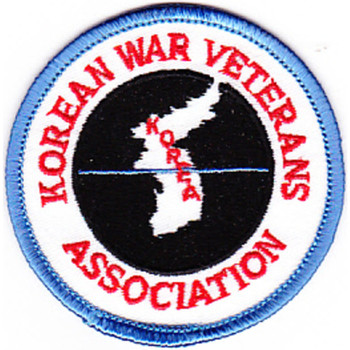Description
Korean War Gray Hair Vets Patch 4.0" x 4.0" Embroidered Patch with Iron-On Backing
Superior Materials: Made with premium polyester thread and durable twill fabric, ensuring long-lasting color and strength.
Advanced Embroidery Technology: Crafted using the most advanced embroidery machinery, guaranteeing intricate detail, sharp lines, and consistent quality every time.
Easy Iron-On Application: Features a heat-activated adhesive backing for quick, no-sew attachment. Simply position, iron, and press for a secure bond.
Versatile Use: Perfect for personalizing jackets, backpacks, uniforms, or any fabric surface that needs a touch of personality.
Durable and Washable: Designed to withstand everyday wear and occasional washing without fading or fraying.
Formations & Origins
The Korean War Gray Hair Vets Patch is an emblem that honors the veterans of the Korean War (1950–1953), a conflict often referred to as "The Forgotten War" due to its overshadowing by the larger and more widely publicized events of World War II and the Vietnam War. The patch is specifically designed for the veterans of this brutal conflict who are now older, reflecting the passage of time and the enduring memory of those who served. The "Gray Hair" part of the title symbolizes the aging of these veterans, many of whom are now in their 80s or 90s. It is a recognition of their sacrifice and service during one of the most pivotal and yet under-acknowledged wars in American history.
The Korean War itself began as a result of the Cold War tensions between the U.S.-backed South Korea and the communist North, led by Kim Il-sung, with the U.S. and its allies (United Nations) supporting the South and China and the Soviet Union supporting the North. What followed was a brutal three-year war that involved intense combat, massive casualties, and profound geopolitical consequences. Despite being overshadowed by later conflicts, the Korean War laid the foundation for the U.S. military's role in Asia and solidified the line between communist and democratic powers in the region, which persists today.
The Gray Hair Vets Patch is a tribute to those who were a part of this forgotten chapter of history. It emphasizes the value of their service, reminding both the public and future generations of the bravery of those who fought in Korea and the significant role the war played in shaping the global balance of power during the Cold War.
Notable Commanders
Several commanding officers played vital roles in the Korean War, and the veterans who wore the Gray Hair Vets Patch served under their leadership. One of the most well-known commanders of the war was General Douglas MacArthur, the supreme commander of the United Nations Command. MacArthur's leadership during the early stages of the war, particularly his successful amphibious landing at Inchon, is considered a decisive turning point in the conflict. MacArthur's bold strategy initially turned the tide in favor of the UN forces, but his later disagreements with President Truman regarding the conduct of the war ultimately led to his dismissal in 1951.
Another significant commander was General Matthew Ridgway, who took over after MacArthur’s dismissal. Ridgway, already known for his leadership in World War II, helped stabilize the UN forces during a critical phase of the war. His successful defense of South Korea and counteroffensive strategies helped to prevent the complete communist takeover of the peninsula. Ridgway’s leadership during the Chinese offensives in late 1950 and early 1951 is widely considered a textbook example of military strategy and leadership under extreme pressure.
Major Campaigns/Operations
The Korean War Gray Hair Vets Patch symbolizes service in one of the most intense and significant conflicts in U.S. military history. Among the most important and notable campaigns of the Korean War were the Battle of Inchon, the Chinese Spring Offensive, and the Battle of Pusan Perimeter.
The Inchon Landing in September 1950 was one of the most daring and successful amphibious operations of the 20th century, led by General MacArthur. It turned the tide of the war in favor of the UN forces, leading to the recapture of Seoul and the eventual push into North Korea. However, as UN forces pushed northward, they faced a devastating surprise counteroffensive from the Chinese People's Volunteer Army in late 1950, which turned the war into a brutal and long-lasting stalemate.
The Battle of Pusan Perimeter in 1950 was another key moment in the conflict. After North Korean forces had advanced rapidly through South Korea, the UN forces were pushed into a small area around the southeastern corner of the peninsula. The battle was one of the most significant defensive operations in military history, where American and South Korean forces held the line against overwhelming odds. Their resistance allowed for the eventual counteroffensive that would push back the North Korean forces.
The Korean War Armistice signed in 1953 officially ended the fighting, though no formal peace treaty was ever signed. The war left a lasting impact, with millions of lives lost and the Korean Peninsula divided into two hostile states—a legacy that continues to shape global politics to this day.
Specialized Role/Equipment
The Korean War, while often overshadowed by other wars in terms of military technology, was still marked by significant advancements in weapons and tactics. For the veterans who wore the Gray Hair Vets Patch, the equipment used during the conflict was cutting-edge at the time and reflected the ongoing arms race of the Cold War.
One of the most notable pieces of equipment used was the M1 Garand rifle, which was the standard-issue rifle for American forces during the Korean War. The rifle was renowned for its accuracy and firepower and served as the backbone of infantry operations. Other notable equipment included the M-26 Pershing tank, which was used to support ground operations, and the F-86 Sabre jet, which played a crucial role in the Korean Air War, engaging in dogfights with Soviet-piloted MiG-15s in the skies over Korea.
Another specialized element was the medical corps and battlefield medicine. The Korean War saw significant developments in military medical care, including the widespread use of medevac helicopters for the evacuation of wounded soldiers. This innovation greatly reduced the time it took to get casualties to hospitals, dramatically improving survival rates.
Acts of Heroism
The veterans who earned the Korean War Gray Hair Vets Patch were often involved in extraordinary acts of heroism, with many receiving high military honors, including the Medal of Honor, for their courage in the face of danger. One such act of heroism was by Corporal Alvin C. York, who single-handedly captured over 130 German soldiers in World War I, but his legacy continued in Korea, where acts of individual bravery were critical in stopping enemy advances.
In Korea, one particularly poignant act of heroism occurred during the Battle of Hill 303, when Private First Class (PFC) Thomas A. Baker repeatedly exposed himself to enemy fire to help rescue his comrades, even after being severely wounded. Despite his injuries, he continued to fight until his last breath, earning him the Medal of Honor posthumously. His story, like many others from the Korean War, represents the intense and often unseen acts of courage that were commonplace during this conflict.
Another notable hero was Lieutenant Colonel (Lt. Col.) Don C. Faith Jr., who led his battalion in a valiant stand against overwhelming enemy forces during the Battle of Chosin Reservoir in late 1950. Despite being surrounded and outnumbered by Chinese forces, Lt. Col. Faith and his men fought on, holding their ground until they were eventually overrun. Faith’s leadership and courage during this desperate battle earned him the Distinguished Service Cross.
Legacy & Notable Achievements
The legacy of the Korean War Gray Hair Vets Patch is one of perseverance and dedication. The Korean War, though often overlooked in American memory, had a profound impact on U.S. foreign policy, the military, and the global balance of power. The war helped solidify the United States' commitment to containing communism, particularly in Asia, and directly influenced future U.S. military engagements in places like Vietnam and later conflicts in the Middle East.
The veterans who wore this patch helped lay the foundation for the modern U.S. military, and their service is marked by the unprecedented challenges they faced. The war’s stalemate led to the establishment of the Demilitarized Zone (DMZ), which still divides North and South Korea today, making it one of the most heavily militarized borders in the world. This symbol of the Cold War divide remains a powerful reminder of the high stakes of the conflict and the role the veterans played in defending democracy and halting the spread of communism.
The Korean War also led to the development of more advanced military tactics and technologies, including jet aircraft, helicopter warfare, and new methods of battlefield medical care. The veterans who wore the Gray Hair Vets Patch are living reminders of the sacrifices made during a war that, though "forgotten" by many, shaped the world in lasting ways.
Today, the patch serves as a reminder of their service and sacrifice, as these veterans have witnessed the passage of time and the evolution of the military they once helped define. As their numbers dwindle, the Korean War Gray Hair Vets Patch stands as a tribute to those who fought, suffered, and triumphed in one of the most important—and yet under-remembered—conflicts in modern history.

















